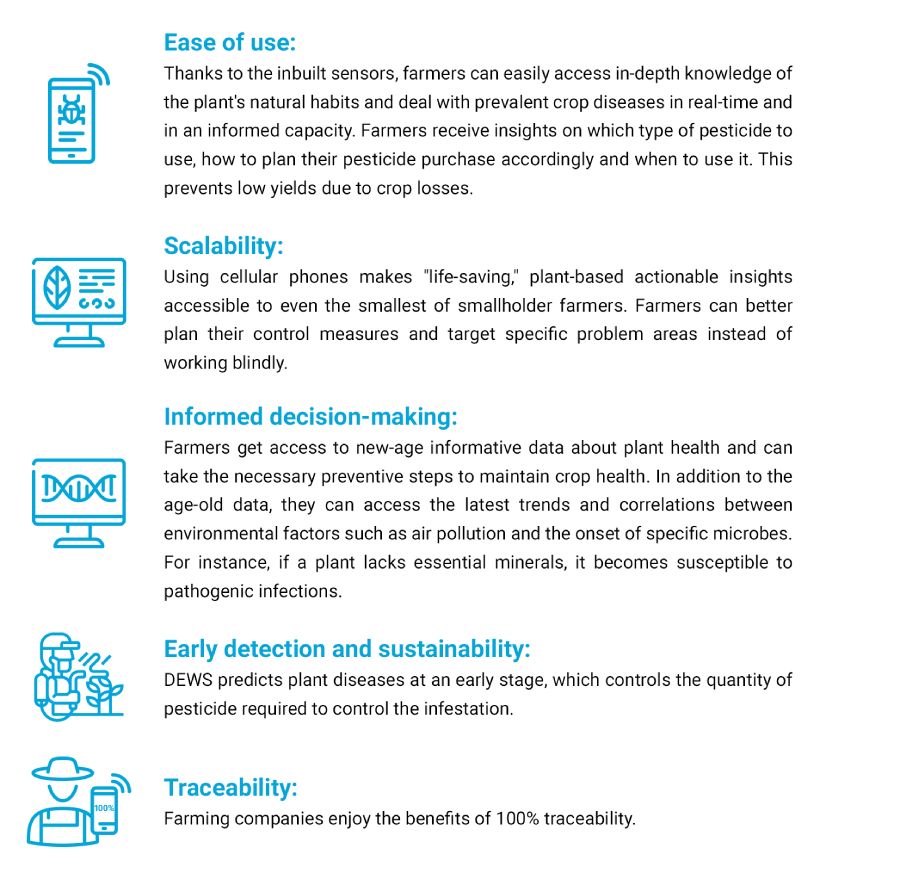Plant disease – a direct threat to agri-food systems
Plant diseases are a severe threat to the food supply. It exacerbates the problem of food supply deficit – a big concern since 800 million people are already inadequately fed. It is essential for farmers to effectively keep a check on plant health to ensure timely prevention and reduce the chances of infestation.
Crop diseases and infestation have a huge impact on productivity as well as crop yield. According to the Food and Agriculture Organization (FAO) of the United Nations, 20%-40% of global crop production is lost to pests annually. Moreover, plant diseases cost the global economy around $220 billion, and invasive insects around $70 billion per annum.
Symptoms of plant disease
Crop diseases have a tell-tale visible effect on the plant– changes in shape, color, or form as the plant responds to the pathogen. This is key to diagnosis. Here are some of the most common symptoms of plant diseases
-
Fungal plant disease symptoms
As per data, 85% of plant diseases are attributed to fungal or fungal-like organisms. Signs are leaf rust, stem rust, white mold, and powdery mildew. Common symptoms include birds-eye spots on berries, leaf spots, and yellowing of leaves. -
Viral plant disease symptoms
The most common symptoms are mosaic leaf patterns, crinkled leaves, yellowed leaves, and plant stunting. -
Bacterial plant disease symptoms
Signs include bacterial ooze, bacterial streaming in water, and water-soaked lesions. Common symptoms are leaf spots having a yellow halo, canker, fruit spots, crown gall, etc.
Identifying pathogens the traditional way
Agronomists must detect potential plant pathogens at the earliest to control pest infestation. The process of identifying a disease may include the following steps:
- Site visit: Following a report of a possible infection, agronomists visit the location
- Analysis: To avoid confusion, they look at other factors that might cause similar symptoms. For example, pathogens or grazing animals can result in leaf damage
- Cause detection: Agronomists try to identify environmental causes, such as pollution, which might affect the plants
- Sample collection: They photograph the symptoms and take samples for laboratory analysis
- Pattern finding: Once an infection is identified, agronomists look for patterns in the distribution of infected plants
Predictably, most plant disease identification techniques are costly and time-consuming, requiring samples to be sent to labs for molecular assays that could take hours to perform. To complicate the problem, getting a sample to the lab can delay the identification process by days or even weeks. Only at the end of it all can agronomists suggest possible control measures to be implemented.
The solution – deeptech in farming is an effective strategy
To tackle the escalating cost and time issues, the internet of things (IoT)-powered technology and devices are incredibly effective in helping farmers identify diseases more quickly. Farmers can be supported with advisories to control infestations at early stages, making the exercise cost-effective and limiting the spread of the disease and related crop damage.
Cropin's Disease Early Warning System (DEWS) is an example of early detection weather-based disease prediction technology. It leverages weather forecasts and the history of the crop’s diseases to predict if a disease can recur. It also considers the crop's growth stage, real-time weather information – details of rainy days, relative humidity, total rainfall, maximum, minimum & average temperatures, and pollution. Cropin's DEWS covers more than 65 disease models spread across 20 crop varieties. The predictions are delivered monthly or fortnightly with relevant, actionable insights, making it extremely convenient for the farmers to work on continuous monitoring with all the critical data at their fingertips.
The benefits of using this mobile app-based DEWS for farmers and farming companies include:

With holistic digital and technical support, farmers can better engage in proactive monitoring and predicting plant diseases, while taking the necessary measures to prevent further deterioration. This predictive intelligence application of disease management lays the foundation for sustainable farming and higher yield output, with food security and plant health at the core.






